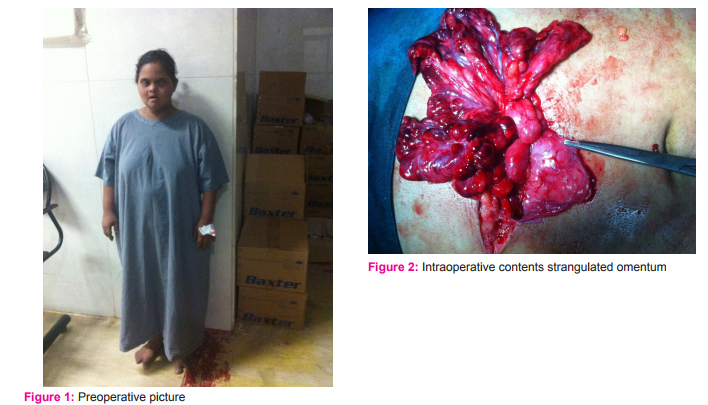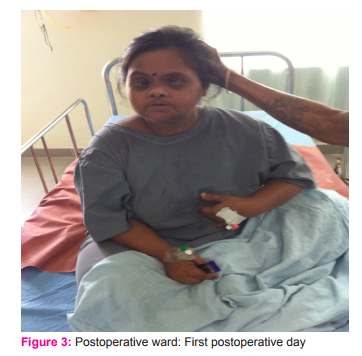IJCRR - 7(9), May, 2015
Pages: 33-35
Print Article
Download XML Download PDF
SPINAL ANAESTHESIA IN DOWN'S SYNDROME- A CASE REPORT
Author: V. Bhavani, Deepak Paulose
Category: Healthcare
Abstract:Patients with Down's syndrome presents with unique set of problems while taking up for surgeries. Anaesthesiologists should have a clear knowledge of pathophysiology and potential problems that can happen intraoperatively and should be equipped to tackle these problems.
Keywords: Chromosomal abnormality, Spinal anaesthesia, Syndrome involves, Breathlessness
Full Text:
INTRODUCTION
Down's syndrome is the commonest chromosomal abnormality with the incidence of 1/800live births. (1). As this syndrome involves all the major systems it poses great challenges to Anaesthesiologist when anaesthetising such patients.
CASE REPORT
35year old female with Down’s syndrome presented with strangulated epigastric hernia for emergency laparotomy. On examination she had a swelling in the epigastric region associated with pain and vomiting. Her last oral intake was four hours back. She had mild mental retardation but was cooperative. Her weight was 55 kg height 145 cms ( BMI-26). History of snoring was present. There was no history of neck pain, breathlessness, recurrent respiratory infection or cyanotic spells. On inspection she was short statured, obese with a short neck. There was mild midfacial hypoplasia and macroglossia with laxity of fingers and elbow joints. Her Mallampatti grade was 2 with normal interincisor and thyromental distances. There was no pallor. On auscultation heart sounds and lung fields were normal. Her blood investigations and ECG were within normal limits. Echocardiography revealed good systolic function. Ultrasound examination of abdomen showed omentum inside the hernia sac. In view of the full stomach, short neck, obese macroglossia and laxity of joints it was decided to do the surgery under spinal anaesthesia. She was taken up under American society of Anaesthesiologists class IIE. Approval was obtained from the caregiver after explaining the anaesthetic technique. She was preloaded with warm Ringer lactate 750 ml and premedicated with ranitidine 50 mg i.v, metaclopromide 10 mg i.v and glycopyrrolate 0.2 mg i.v. Her ECG, pulse oximetry, and blood pressure were monitored. She was cooperative but was unable to comprehend that she had to lie still for administering spinal anaesthetic. So midazolam 1.5 mg i.v was given to keep her calm. Spinal anaesthesia was administered in right lateral position using 25G Quincke’s needle with 2ml 0.5% hyperbaric bupivacaine and fentanyl 25 micrograms(2) as additive. After administering spinal anaesthesia she was placed in supine position. A sensory level of T4 was achieved.(3) Oxygen was supplemented using facemask at 5l/min. Intraoperatively she had two episodes of hypotension which were treated with Inj. Mephentermine 5mg iv. Omentectomy and anatomical closure of epigastric hernia repair was done. Procedure lasted for one hour and she tolerated the surgery well. Patient was shifted to postoperative ward where she was continuously monitored. Her postoperative period was uneventful. She was given Injection Tramadol 50 mg intramuscular 8th hourly for her postoperative pain.
DISCUSSION
Skillful Anaesthetic management is mandatory in patients with Down’s syndrome for better postoperative results. In our case we decided to proceed with spinal anaesthesia because of , full stomach, short neck, obese macroglossia and laxity of joints and she was hemodynamically stable. .Although our patient did not exhibit signs of Atlanto occipital instability such as brisk deep tendon reflexes or ankle clonus presence of laxity of upper limb joints might be a predisposing factor for Atlanto occipital Instability. (1) The risk of general versus regional was considered in our patient and finally regional was decided because of the above said reasons. Meticulous dose titration was done and dose was calculated based on height of the patient 0.06 mg/cm height(2)(3) . Our patient height being145 cm, the dose of bupivacaine calculated was 8.7mg and it was approximated to 10mg(2ml).The total volume used was 2.5ml (2ml bupivacaine with 25 micrograms of fentany
CONCLUSION
Although not many cases are reported in literature spinal anaesthesia can still be considered as a option in selected cases of Down’s syndrome because of the multisystem involvement. As these patient exhibit an array of problems, we should deliver a safe anesthetic technique. Meticulous planning in preparing the patient, and selecting the patient, discussion of risks and technical problems extra watchfulness during intraoperative and postoperative care should be undertaken. In future many such cases will pose great challenges to anaesthesiologists as the maternal age of conception is increasing.
ACKNOWLEDGEMENT
Authors acknowledge the immense help received from the scholars whose articles are cited and included in references of this manuscript. The authors are also grateful to authors / editors / publishers of all those articles, journals and books from where the literature for this article has been reviewed


References:
1. Bhattarai, B., Kulkarni, A. H., Rao, S. T., and Mairpadi, A. (2008). Anesthetic consideration in downs syndrome-a review, 10(3), 199–203.
2. Lee, Y., Balki, M., Parkes, R.,and Carvalho, J. C. A. (n.d.). Dose Requirement of Intrathecal Bupivacaine for Cesarean Delivery Is Similar in Obese and Normal Weight Women, 679–683.
3. Tanvir Samra and Sujata Sharma Estimation of the dose of hyperbaric bupivacaine for spinal anaesthesia for emergency caesarean section in an achondroplaIndian J Anaesth. 2010 Sep-Oct; 54(5): 481–482.
4. Hubert J. Schmitt MD Erlangen, Germany Spinal anesthesia in a patient with Down’s syndrome C J A 638-639
|






 This work is licensed under a Creative Commons Attribution-NonCommercial 4.0 International License
This work is licensed under a Creative Commons Attribution-NonCommercial 4.0 International License